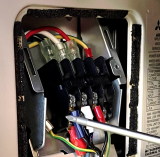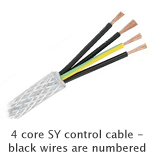Electrical connections
You should consult a qualified electrician before commencing any work.
Also see the information about the ’electricity supply’.
Wiring configuration
 The majority of mini-split units rely on a well-earthed, RCD protected, mains supply to the outdoor unit. A four-core cable then passes power and control signals to the indoor unit. This cable is often run alongside the insulated refrigerant lines (i.e. not directly against the copper pipework).
The majority of mini-split units rely on a well-earthed, RCD protected, mains supply to the outdoor unit. A four-core cable then passes power and control signals to the indoor unit. This cable is often run alongside the insulated refrigerant lines (i.e. not directly against the copper pipework).A small minority of systems require power supplied to the indoor unit, with a control cable to the outdoor unit. This configuration is more unusual because the outdoor unit uses more power and therefore a heavier duty cable is required between the units. However, it has the advantage of simpler outdoor wiring, using just one cable.
Types of cable
The considerations for the cable are:
-
Rating - the size of the copper cores
Most mini-splits require 2.5mm2 cable for the main feed and 1.5mm2 interconnect cable. The manufacturer specifications and installation instructions should have the details. Remember, bigger cable is OK, smaller isn’t! -
Outdoor rated cable
 Outdoor cabling should be outdoor rated! For the main power connection use outdoor rated 3 core cable which is easy to source.
Outdoor cabling should be outdoor rated! For the main power connection use outdoor rated 3 core cable which is easy to source.
For the control cable, many air-con suppliers offer four core SY cable which has a strong outer steel braid. However, most SY cable is not UV resistant, meaning it must be protected from sunlight - a black plastic flexible conduit is a good option. Alternatively, a more specialist and expensive UV rated cable can be used.
- RS components websitehas an interesting article on SY cable.
- Byson cablesare one company who offer a range of tough and UV resistant cables.
-
Connection terminations
Some manufacturers recommend terminating the cable cores with ring terminals. This helps make a stable and reliable connection in the stressed environment of the outdoor unit.